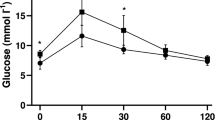Abstract
Chronic vasodilatation represents a stimulus for capillary growth associated with increased luminal shear stress. We have examined the ultrastructure of more than 2000 capillaries to establish whether the sequence of angiogenesis in response to this stimulus is similar to that described during development and under pathological circumstances. Administration of the α1-blocker prazosin to rats for 2 weeks led to a greater capillary length density in extensor hallucis proprius muscles without any change in capillary tortuosity: J v(c,f)=262±54 compared with 350±17 mm–2, control compared with prazosin (P<0.002). There were obvious signs of endothelial cell (EC) activation after prazosin treatment, including an increased proportion of capillaries with rough endoplasmic reticulum, large cytoplasmic vacuoles, thickened endothelium and an irregular luminal surface. Capillaries from control muscles had a maximum of three ECs in cross section, whereas four ECs were noted in 0.8+0.5% of capillaries after 1 week (n.s.) and 2.5±0.9% after 2 weeks (P<0.01) of treatment. This could be due to elongation and/or migration of ECs, as cell proliferation has not been described at these time points. There was also an increase in the proportion of capillaries having a narrow, slit-like lumen (1.7±0.8% of controls; 7.1±1.9% at 1 week; 8.8±2.5% at 2 weeks; P<0.02), some of which were smaller in size (less than 2 μm diameter) than in controls (3–5 μm) and/or “seamless”, i.e. lacking EC junctions. These may represent newly formed vessels. Focal discontinuity of the basement membrane and abluminal EC processes were rarely seen, and capillary growth by abluminal sprouting appeared to be very infrequent (less than 0.001% of profiles). Of more importance was growth starting from the luminal side. Significantly more thin cytoplasmic processes were observed protruding into the lumen of capillaries after 1 week (47.5±6.2%, P<0.001) and 2 weeks of prazosin (34.2±5.5%, P<0.05) than in control vessels (16.7±3.9%). Some of these traversed the entire lumen and connected with endothelium of the opposite side, probably involving membrane fusion, resulting in the appearance of a double lumen. Individual capillaries with a complete double lumen were observed after 2 weeks’ prazosin but comparatively rarely, in only four out of six muscles. These findings indicate a pattern of luminal growth which is completely different from intussusceptive growth previously described during development, and from the abluminal capillary sprouting seen under pathological circumstances.
Similar content being viewed by others
Author information
Authors and Affiliations
Additional information
Received: 22 July 1997 / Accepted: 9 February 1998
Rights and permissions
About this article
Cite this article
Zhou, AL., Egginton, S., Hudlická, O. et al. Internal division of capillaries in rat skeletal muscle in response to chronic vasodilator treatment with α1-antagonist prazosin. Cell Tissue Res 293, 293–303 (1998). https://doi.org/10.1007/s004410051121
Issue Date:
DOI: https://doi.org/10.1007/s004410051121




